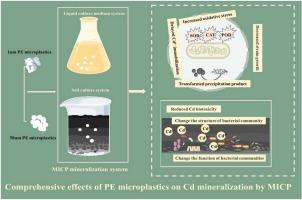Polyethylene microplastics interfere with MICP-based cadmium remediation: A dual-system evaluation of microbial performance and environmental response
IF 11.3
1区 环境科学与生态学
Q1 ENGINEERING, ENVIRONMENTAL
引用次数: 0
Abstract
Microbially induced calcite precipitation (MICP) is a sustainable and effective approach for immobilizing heavy metals such as cadmium (Cd) in contaminated environments. However, the influence of coexisting microplastics (MPs), particularly polyethylene microplastics (PE-MPs), on MICP performance remains unclear. This study systematically investigated the effects of 1 μm and 50 μm PE-MPs on MICP-mediated Cd remediation in both liquid cultures and soil systems. In aqueous systems, PE-MPs imposed oxidative stress on Stenotrophomonas maltophila Z-6 (with CAT and SOD activities increased by 15.83–59.44 % and 37.41–149.81 %, respectively), inhibited bacterial growth (OD₆₀₀ decreased by 0.20–8.43 %), and delayed Cd²⁺ immobilization. Notably, low-to-moderate concentrations of 1 μm PE-MPs exerted greater inhibitory effects. SEM and XRD analyses showed a transformation of mineral products from metastable spherical vaterite to stable stacked calcite, enhancing Cd fixation, especially at low concentrations of 1 μm PE-MPs. In soil, PE-MPs altered MICP-induced pH (decreased 0.075–0.096 units), EC (decreased 4.52–10.73 %), enzymatic activities, and microbial community structure, yet promoted overall mineralization and reduced Cd mobility and bioavailability (1.98–2.79 %). These findings highlight the complex effects of PE-MPs on MICP performance and microbial ecological stability, underscoring the need to account for emerging pollutants in MICP-based remediation strategies.

聚乙烯微塑料干扰基于micp的镉修复:微生物性能和环境响应的双系统评估
微生物诱导方解石沉淀(MICP)是一种持续有效的固定污染环境中重金属镉(Cd)的方法。然而,共存微塑料(MPs),特别是聚乙烯微塑料(PE-MPs)对MICP性能的影响尚不清楚。本研究系统研究了1 μm和50 μm PE-MPs对液体培养和土壤系统中micp介导的Cd修复的影响。在水体系中,PE-MPs对亲麦寡养单胞菌Z-6产生氧化应激(CAT和SOD活性分别升高15.83-59.44%和37.41-149.81%),抑制细菌生长(OD₆₀0降低0.20-8.43%),并延迟Cd 2 +的固定化。值得注意的是,低至中等浓度的1 μm PE-MPs具有更大的抑制作用。SEM和XRD分析表明,在低浓度1 μm PE-MPs下,矿物产物从亚稳的球形水晶石转变为稳定的堆积方解石,增强了Cd的固定作用。在土壤中,PE-MPs改变了micp诱导的pH(降低0.075 ~ 0.096个单位)、EC(降低4.52 ~ 10.73%)、酶活性和微生物群落结构,但促进了整体矿化,降低了镉的迁移率和生物利用度(1.98 ~ 2.79%)。这些发现强调了PE-MPs对MICP性能和微生物生态稳定性的复杂影响,强调了在基于MICP的修复策略中考虑新出现的污染物的必要性。
本文章由计算机程序翻译,如有差异,请以英文原文为准。
求助全文
约1分钟内获得全文
求助全文
来源期刊

Journal of Hazardous Materials
工程技术-工程:环境
CiteScore
25.40
自引率
5.90%
发文量
3059
审稿时长
58 days
期刊介绍:
The Journal of Hazardous Materials serves as a global platform for promoting cutting-edge research in the field of Environmental Science and Engineering. Our publication features a wide range of articles, including full-length research papers, review articles, and perspectives, with the aim of enhancing our understanding of the dangers and risks associated with various materials concerning public health and the environment. It is important to note that the term "environmental contaminants" refers specifically to substances that pose hazardous effects through contamination, while excluding those that do not have such impacts on the environment or human health. Moreover, we emphasize the distinction between wastes and hazardous materials in order to provide further clarity on the scope of the journal. We have a keen interest in exploring specific compounds and microbial agents that have adverse effects on the environment.
 求助内容:
求助内容: 应助结果提醒方式:
应助结果提醒方式:


